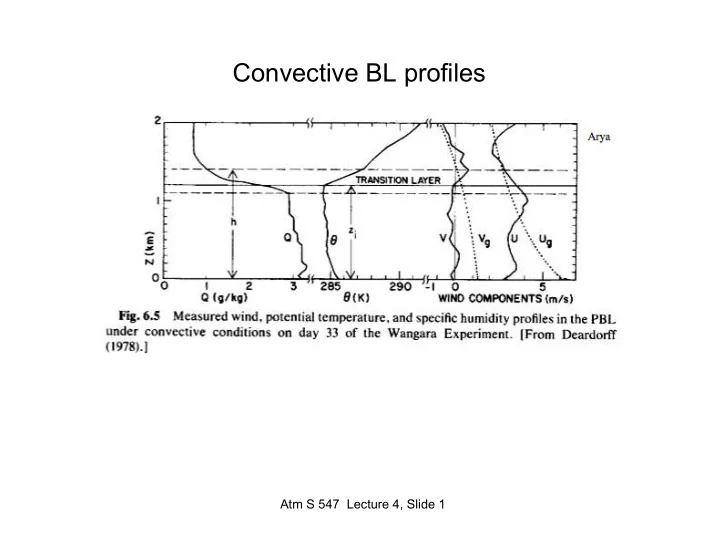

Convective BL profiles Atm S 547 Lecture 4, Slide 1
Moderately stable BL profiles Atm S 547 Lecture 4, Slide 2
Highly stable BL profiles Wind hodograph at South Pole Station Categories 1-8 correspond to increasingly stable BLs; dots are composites of measurements at 0.5, 1, 2, 4, 8, 12, 16, 20, 24, 32 m; y -axis is in the surface wind direction. Note large turning of the wind with height in stable BLs. Atm S 547 Lecture 4, Slide 3
ABL observing technologies - Surface measurements Surface measurements • Sonic anemometers (fast-response air velocity), ocean buoys • Fast-response temperature, humidity, gas sensors • Surface meteorology, chemistry, aerosols • Downward radiation Sonic + gas analyzer for Pyranometer eddy-correlation CO2 flux Sonic anemometer Atm S 547 Lecture 4, Slide 4
ABL obs - Remote sensing • Doppler lidar (aerosol scattering), ceilometers, nephelometers • mm-wavelength radar (cloud scattering) • Sodar and 915 MHz wind profilers • RASS (virtual temperature profiling via Bragg scattering of radar waves from sound-induced density anomalies moving away at sound speed) Phased-array Doppler sodar RASS + wind profiler Doppler lidar (ABL wind profiling) Atm S 547 Lecture 4, Slide 5
ABL obs - Specialized platforms • Flux towers for measurements at multiple heights • Tethered balloons • Aircraft/helicopter Cabauw 220 m flux tower, NL Robotic helicopter with gas-sensing instrumentation Atm S 547 Lecture 4, Slide 6
Large eddy simulation (e. g. SAM or WRF) • Discretize and solve 3D compressible or Boussinesq fluid equations on a grid. • Grid spacing << size of most energetic eddies (typically 5 -50 m in vertical, 1-5x larger in horizontal) • Horizontal domain size > size of most energetic eddies (typically 2 km (stable BL) – 20 km (convective BLs w • Typically use horizontally periodic boundary conditions • Advect potl. temp, other quantities of interest, (moisture, chemical constituents) using sophisticated schemes that minimize spurious oscillations, maintain accuracy • Subgrid turbulence scheme (‘Smagorinsky’ eddy diffusion) • Other relevant physics (surface fluxes, radiation, clouds) • Effects of large-scale advection added if periodic BCs used Atm S 547 Lecture 4, Slide 7
LES of atmospheric boundary layer Application I: Visualization See class web-page links to animations of LES-simulated: Sc-capped BL (4x4 km, courtesy B. Stevens, UCLA): - Vertical cross-section of w - horizontal view of cloud albedo Cu rising into Sc (6x6 km, courtesy I. Sandu, ECMWF) (white is cloud; grey blobs are rain) Atm S 547 Lecture 4, Slide 8
Application II: Turbulence fluxes and statistics Stevens et al. 2005 Atm S 547 Lecture 4, Slide 9
Application III: Parameterization development/testing GABLS-1 idealized stable boundary layer (Beare et al. 2006) • Stable stratification, V g = 10 m s -1 • Surface cooled at 0.25 K hr -1 for 9 hrs. • Several LESs run with 3 m resolution. • Compared with new (UW) and existing PBL parameterizations in NCAR ’ s CAM3 climate model. • New and modified schemes clearly outperform current approach compared to Bretherton and Park (2009 J.Clim) LES for this case. Atm S 547 Lecture 4, Slide 10
Recommend
More recommend